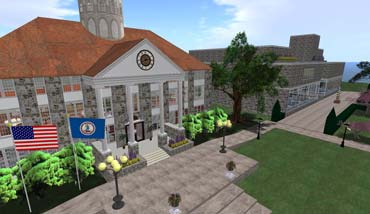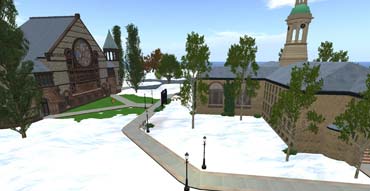Real-Life Teaching in a Virtual World
Few technologies have been subject to more hype and subsequent disappointment than Second Life. Corporations from shoe manufactures to cruise lines to news services set up shop with hopes this new frontier would bring soaring profits. Most evacuated shortly thereafter when the effort resulted in spaces devoid of audiences and buyers. A notable exception, though, is education.
Education is thriving in Second Life. This enthusiastic subculture is abuzz within the Second Life realm, constantly interacting inside and outside Second Life. Educators are exploring every possible tool the 3D virtual world offers and establishing best practices along the way.
Linden Lab, the creator of Second Life, reports on the company's Web site that universities such as Harvard, Texas State, and Stanford have Second Life campuses. While Linden Lab states that more than 200 educators and about as many universities are using Second Life, all signs point to a far larger community.
The Second Life Educators (SLED) community is an e-mail list that includes more than 4,700 working in or interested in education in Second Life. SLED was created in October 2005 to help newcomers adjust to Second Life, exchange resources, network, collaborate on projects, and share best practices.
Real Life Education in Second Life is a group inside the 3D realm that boasts 3,500 members. It is for sharing information, asking questions, and getting notices of in-world and "real life" events.
CC International is a group of 4,200 that promotes the use of virtual reality for education. The goal is to provide training seminars and certificates in building, scripting, furniture making, and more, offering college-level classes for credit, possibly toward a degree.
Thousands are involved in these three groups alone. There are many more groups, some of which focus on fields of study, such as architecture, music, and business.
How Educators Use Second Life
Some universities and colleges use the tools provided in Second Life to build exact replicas of their campuses. The virtual recreations can be used as recruiting tools to reach students and teachers and to showcase the institutions to other important audiences, such as donors.

James Madison University's Second Life working campus
The more active educational uses of Second Life take advantage of the immersive experience. Some faculty teach classes within Second Life, and others use Second Life as a supplement to traditional classroom environments and for enriching an existing curriculum. Educators say the immersion facilitates experiential learning, simulation, roleplay, collaboration, co-creation, experimentation with new ideas, and learning from teachers and from each other. One professor even teaches education students how to use Second Life in their lesson planning.
"My job is to look at emerging technologies and see how they can be used," said Sandra Sutton Andrews, an educational researcher at Arizona State University College of Education. "Good use of technology is not using bells and whistles for their bells and whistles. Good use of technology has research that backs it up."
Andrews said she takes education students into Second Life to teach them how to use the technology appropriately. She is currently introducing science students to the 3D realm.
"The virtual world gives a greater sense of presence than discussion boards," said Andrews. "The students get a better feel for the teacher, and it is more fun."
And there is another, simpler use for Second Life: office hours. Instructors and their students can communicate in text or by speaking over a microphone in Second Life while at home or in an office, eliminating the need to travel.
(For more uses of Second Life, go to sleducation.wikispaces.com/educationaluses.)
The Appeal
The immersive environment is unlike any other teaching venue. Astronomy can be taught using virtual planetariums with stars you can click on to learn their temperatures. Literature can be taught within buildings designed to replicate structures described in a novel, and in the era they existed. Chemistry students can walk inside a molecule. Even emergency responders learn by 3D simulations complete with timed events to which they must react.

Virtual Princeton
Real-time meetings and collaboration, in contrast to Web pages, are far more engaging. A 3D virtual environment is believed to increase participation and improve retention. It also allows students to meet and learn from each other no matter their geographical location.
The fun factor can't be ignored, either. While some people think Second Life is too much fun for a serious endeavor, many teachers will retort that learning should be fun. A learning environment such as Second Life can make students eager to join the classes or projects.
Another significant benefit to using Second Life is the availability of multimedia presentation tools. An instructor can load a PowerPoint presentation onto a virtual screen, play a video on a virtual monitor, and type Web site URLs students can launch immediately within the program. Teachers hand out class notes or other literature on note cards that can be copied into Word documents, and can make graphics that are clickable to reveal more information.
Finally, you can't beat the price. Second Life is free to join, so both teachers and students pay nothing to get started. Virtual land--the meeting space--has a fee, but Linden Lab gives a discount to educational institution.s (See secondlife.com/land/privatepricing.php).
In further cost savings, instructors can load a PowerPoint presentation or a video without investing in expensive projectors or screens. This can mean a huge financial savings--less wear and tear on hardware and in some cases, even elimination of the equipment.
Getting Started
It's important to note that Second Life requires a computer with hefty specs to run properly, which could be a barrier to entry for some. Fortunately, computers sold today are adequate.
In the coming weeks, we will delve in to take a look at specific ways universities and colleges are using Second Life.
Meanwhile, you can check it out at secondlife.com.